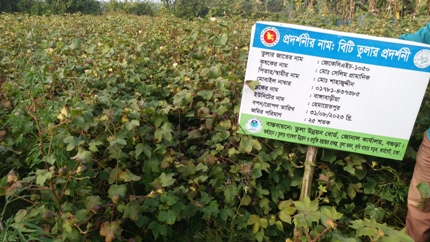-
- About Us
-
Our Services
Downloads
Services
Training & Opinion
-
Other Offices
Divisional/Upazila Offices
Ministry/ Division/ Department
- E-Service
- Gallery
- Contact
- Opinion
- SDG Related
-
- About Us
-
Our Services
Downloads
সিটিজেন চার্টার
সিটিজেন চার্টার
Services
Training & Opinion
-
Other Offices
Divisional/Upazila Offices
Ministry/ Division/ Department
- E-Service
- Gallery
-
Contact
Official Contact
Contact Map
- Opinion
-
SDG Related
এসডিজি বিষয়ক
তুলা গবেষণা
Cotton Research
Cotton Development Board (CDB) has been conducting research on different aspects of cotton production since 1991. The main focus of cotton research in Bangladesh include development of hybrid and short duration high yielding cotton varieties with desirable fiber characteristics, generation of agronomic management technologies to increase productivity, improving soil fertility by integrated management of organic and inorganic fertilizers, identification of bio-pesticide in controlling cotton insect pest and cotton disease management. Besides, research on stress management has been prioritized to expand cotton cultivation in the hill, char, saline and drought areas combining the traditional knowledge and skill with biotechnology tools.
Cotton hybrid has been cultivating in Bangladesh for couple of years through Public-Private Partnership (PPP) for cotton Research and Development in Bangladesh. Within this initiative, Supreme Seed Co. Ltd has imported hybrid cotton seed from China and CDB has conducted research to find out adaptability and to generate production technologies. Cotton hybrid was widely accepted by the farmers due to its high yielding capacity (3-4 t/ha seed cotton), by the Ginners due to its high Ginning Out Turn (GOT) and by the Spinners due to its desirable fiber characteristics.
National Committee on Biosafety (NCB) has approved for conducting contained trial of Bt hybrid of cotton from July/2015 at Sreepur research farm. With the permission of Ministry of Agriculture, Material Transfer Agreement (MTA) has signed between CDB and Hubei Provincial Seed Group Co. Ltd., Wuhan, China to make available Bt hybrid seed for contained trial. So Bt hybrid cotton seed will be available to the farmers in near future.
CDB has been implementing its research program in five disciplines like as:
- Breeding
- Agronomy
- Soil Science
- Entomology
- and Plant Pathology
CDB has 5 research farms/stations and three research sub-stations. Those are:
- Cotton Research, Training and Seed Multiplication Farm, Sreepur, Gazipur
- Cotton Research, Training and Seed Multiplication Farm, Sadarpur, Dinajpur
- Cotton Research, Training and Seed Multiplication Farm, Jagadishpur, Jessore
- Cotton Research Station, Mahigonj, Rangpur
- Hill Cotton Research Station, Balaghata, Bandarban
- Hill Cotton Research Sub-station, Raicha, Bandarban
- Hill Cotton Research Sub-station, Kaokhali, Rangamati
- Hill Cotton Research Sub-station, Matiranga, Khagrachari
Areas under cotton Research Farm/Station
|
Sl. no. |
Name of Research Farm/Station |
Total Area (acre) |
Cultivable area (acre) |
Office, Residential building, Road, orchard etc. (acre) |
|
1 |
Sreepur, Gazipur |
150 |
112 |
38 |
|
2 |
Sadarpur, Dinajpur |
128 |
84 |
44 |
|
3 |
Jagadishpur, Jessore |
157 |
111 |
46 |
|
4 |
Mahigonj, Rangpur |
23.50 |
18 |
5.5 |
|
5 |
Balaghata, Bandarban |
15 |
9.26 |
5.74 |
|
Total= |
473.50 |
334.26 |
139.24 |
|
The total manpower of these five farms are 60 among that the number of Scientist is 26.
Total Manpower involved in cotton research
|
Type of Post |
Total Approved Post |
Total Research Posts |
Total Scientist Post |
|
|
1st Class/Technical |
115 |
26 |
CSO |
1 |
|
2nd Class/ Technical |
17 |
0 |
PSO |
4 |
|
3rd Class |
520 |
25 |
SSO |
8 |
|
4th Class |
228 |
9 |
SO and others |
13 |
|
Total |
880 |
60 |
|
26 |
Technologies generated by research:
Cotton Development Board has generated 43 technologies by research.
|
Sl. No. |
Discipline |
No. of technologies |
|
1 |
Breeding |
19 (varieties) |
|
2 |
Agronomy |
16 |
|
3 |
Soil Science |
8 |
|
4 |
Entomology |
7 |
|
5 |
Pathology |
2 |
A. Breeding Discipline
|
1. |
Released 15 upland cotton varieties; such as, CB-1, CB-2, CB-3, CB-4, CB-5, CB-6, CB-7, CB-8, CB-9, CB-10, CB-11, CB-12. CB-13 ,CB-14 CB-15and CB Hybrid 1 |
|
2. |
Released 3 hill cotton varieties; such as, HC-1 (White) and HC-2 (Khaki).HC-3 |
|
***Some of the released cotton varieties, such as, CB-12, CB-14 and CB-15 are widely used for cultivation in the farmers’ field for economic yield. |
|
B. Agronomy discipline:
|
1. |
Development of Package of Practice for Hybrid and Modern Cotton Variety. |
|
2. |
Suitable sowing time of upland cotton- 15 June to 15 July. Suitable sowing time of hill cotton–15 April to May |
|
3. |
Suitable spacing of upland cotton - 90cm×45cm. Suitable spacing of hill cotton– 60cm×30cm. |
|
4. |
Poly bag seedlings production system for upland cotton. |
|
5. |
Intercropping of upland cotton with vegetables, oil crop and pulse crops. Intercropping of hill cotton with rice, maize and chili crops. |
|
6. |
Relay cropping of upland cotton with wheat and maize. |
|
7. |
Cropping pattern determination: Cotton/wheat-vegetables, Cotton/wheat- sesame, Cotton/wheat- Yard long bean. |
|
8. |
De topping at the age of 70-80 days plant. |
|
9. |
Earthing-up at the age of 40-60 days plant. |
|
10. |
Uses of Plant growth Regulators for Cotton Production |
|
11. |
Chili-cotton intercropping in CHT hill slope and plain land. |
|
12. |
Rice-Cotton intercropping in CHT hill slope |
|
13. |
Introduction of summer cotton |
|
14. |
Rate and application system of Plant Growth Regulator determination at the time of flowering stage. |
|
15. |
Upland and hill cotton cultivation technology for zero tillage system |
|
16. |
Technology development for Cotton production in saline soil |
C. Soil Science Discipline
|
1. |
Fertilizer Recommendation of Newly release upland and hill cotton variety |
|
2. |
Time, method and doses of fertilizer application; |
|
3. |
Foliar application method development for N, K, B, and Zn fertilizers in cotton field. |
|
4. |
Time and split application of NPK fertilizer on seed cotton yield |
|
5. |
Time, method and doses of fertilizer application in cotton based Jhum Farming system |
|
6. |
Fertilizer application method in Jhum |
|
7. |
Uses of poultry manure on cotton cultivation |
|
8. |
Recently uses of Urea Super Granule on cotton production |
|
|
|
D. Entomology discipline:
|
1. |
For sucking pests – Monocrotophos @ 3ml/1L determination |
|
2. |
For chewing pests – Pyrithroid @ 3ml/1L determination. |
|
3. |
ETL determination. |
|
4. |
Insecticide application rate determination on the basis of Scouting and ETL. |
|
5. |
Efficiency determination of Sprayer machine. |
|
6. |
Determination of boll worm control technology by hand picking of moths. |
|
7. |
Applications of pheromone trap, molasses trap, light trap, parching and various botanicals. |
E. Pathology discipline:
|
1. |
Control of seedling blight disease, Vitavex-200 or Bavistin @2-3g/kg should be used for cotton seed treated. |
|
2. |
For Boll rot and Leaf spot disease control, application and rate of Cupravit, Macuprex or Dithane, M-45 determination. |
Planning and Implementation: Cabinet Division, A2I, BCC, DoICT and BASIS












